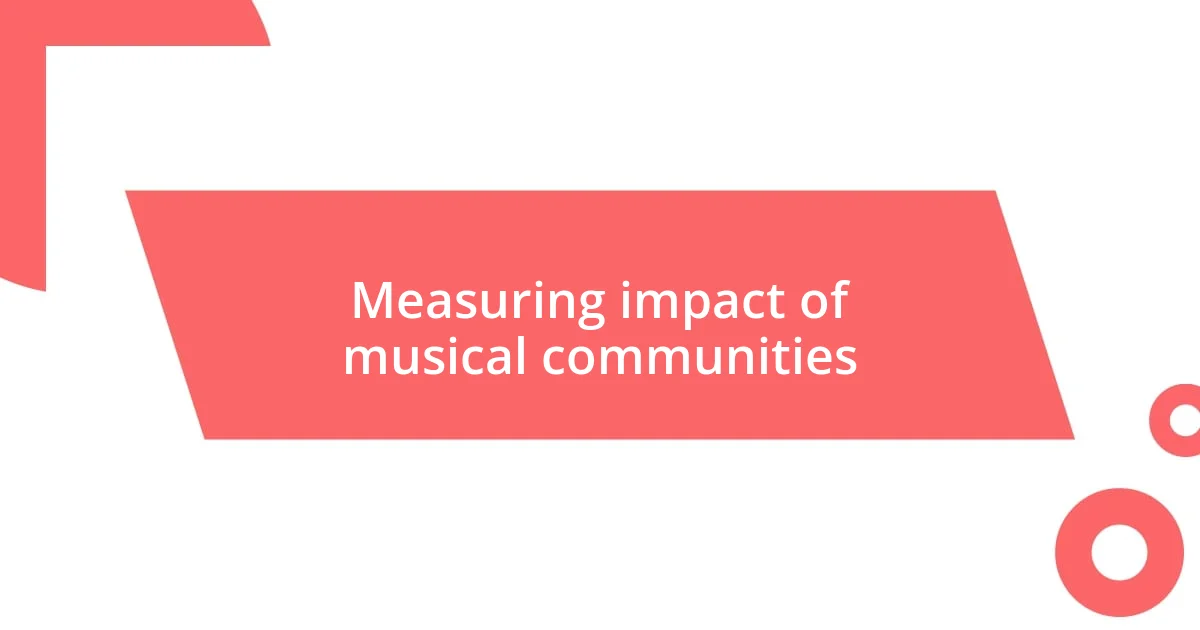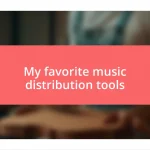Key takeaways:
- Music serves as a universal language that fosters community connections and shared experiences, transcending barriers of background and ability.
- Creating inclusive music events requires thoughtful strategies, including diverse lineups, accessibility features, and promoting safe spaces for expression.
- Measuring the impact of musical communities involves both quantitative data and qualitative feedback, highlighting the emotional bonds and ongoing engagement that music cultivates.

Understanding community through music
Music has an incredible ability to bind people together. I recall a night at a local open mic where strangers became friends over shared songs and laughter. In those moments, I realized how music acts as a universal language, breaking down barriers and fostering connections within a community.
When I think about the impact of music in my life, I remember attending a community festival. The energy was palpable as people from diverse backgrounds united to enjoy performances. How powerful is it that a single melody can evoke memories, spark conversations, and create a sense of belonging? It’s moments like these that highlight the emotional tapestry music weaves within a community.
Have you ever noticed how a song can bring back memories of a specific time and place? For me, it’s a simple tune that takes me back to childhood summer days spent with friends, singing and dancing. Music isn’t just about sound; it’s about emotion and shared experiences. By tapping into these sentiments, we can foster deeper connections and understand the essence of our communities.

Strategies for inclusive music events
When planning inclusive music events, it’s essential to create a space that welcomes everyone. I vividly remember a community concert where volunteers stepped up to ensure accessibility for all attendees. From wheelchair ramps to sign language interpreters, these thoughtful details made such a difference. By prioritizing inclusivity, we can create experiences that everyone can enjoy, regardless of their background or ability.
To enhance inclusivity at music events, consider implementing the following strategies:
- Diverse Lineups: Showcase a variety of musical genres and artists from different cultural backgrounds, ensuring a more comprehensive representation.
- Accessibility Features: Provide ramps, seating areas, and quiet zones for those who might need a break from the sensory overload of a live event.
- Engagement Activities: Incorporate interactive workshops or discussions that allow attendees to share their own stories and connect with one another.
- Promote Safe Spaces: Foster an environment where all attendees feel comfortable expressing themselves without fear of judgment or exclusion.
- Feedback Mechanisms: Actively seek opinions from the community to continually improve the inclusivity of future events.
It’s these small yet significant efforts that can transform a music event into a truly community-centered celebration.

Building platforms for musical exchange
Understanding the importance of building platforms for musical exchange brings to light the many ways we can connect through sound. I once participated in an online music collaboration where musicians from around the globe shared their tracks. It was fascinating to hear how a simple melody could evolve through different interpretations, blending diverse cultural influences. This experience opened my eyes to how technology can bridge gaps and create new avenues for collaboration beyond geographical boundaries.
When we think about creating effective platforms for musical exchange, we should consider accessibility and user-friendliness. I remember when a friend introduced me to a grassroots initiative that encouraged local artists to record and share their music through a community-driven website. The ease of access allowed many voices to be heard, helping to cultivate a rich tapestry of sounds unique to our area. By ensuring that these platforms are not only available but also engaging, we can inspire more people to participate and share their artistry.
Additionally, fostering environments where individuals feel comfortable exchanging their musical ideas is vital. I think back to a jam session at a cozy café where participants could freely improvise. Each person brought something different to the table, and the outcome was a beautiful collaboration that none of us expected. This spontaneity has always shown me that when we build supportive platforms for musical expression, the results are often magical and profoundly unifying.
| Platform Type | Key Features |
|---|---|
| Online Collaboration Tools | Global reach, diverse input, ease of sharing |
| Community Sound Platforms | Local focus, emphasis on inclusivity |
| Live Performance Spaces | Immediate interaction, spontaneous creativity |

Engaging diverse audiences effectively
Engaging diverse audiences effectively requires us to truly listen to their needs and preferences. I recall a festival where we surveyed attendees beforehand. The insights gathered reshaped our lineup to include local artists who resonated with various cultural groups. This tailored approach fostered a sense of belonging, making everyone feel seen and heard.
Understanding that music speaks differently to different people is crucial. One particular event stands out, where we included workshops focused on various cultural music styles. Participants shared their stories and traditions, which created an incredible opportunity for connection. It’s amazing how a single melody can evoke such varied emotions and memories, isn’t it? This kind of engagement transforms ordinary events into rich cultural exchanges.
Building relationships with our audience is about more than just a performance; it’s about creating an ongoing dialogue. I remember chatting with an attendee at an open mic night who expressed how the event gave him a platform to share his music for the first time. Seeing the confidence in his eyes as he took the stage was inspiring. It highlighted for me the profound impact we can have by simply encouraging diverse voices. How do we ensure that every individual feels empowered to connect through music? By actively inviting participation, we can enchant audiences and enhance their sense of community.

Measuring impact of musical communities
Measuring the impact of musical communities can be quite nuanced, but I’ve found that both quantitative and qualitative approaches can offer valuable insights. For instance, after hosting a series of local music workshops, we collected feedback through informal chats and surveys. Participants shared not only their enjoyment but also how these gatherings helped them feel more connected to their neighbors. Seeing the smiles and hearing the stories reaffirmed that the emotional bond created by music can truly enhance community ties.
I remember another instance where we assessed the reach of an online collaboration project. By analyzing metrics like the number of contributors and social media engagement, we were able to gauge its success. However, the real testament came when people began sharing their personal journeys in the comments. It struck me how music ignited conversations that crossed generational divides and geographical borders. Isn’t it incredible how shared melodies can lead to such deep connections and reflections?
Ultimately, the impact of musical communities can be measured through the growth of relationships and the creation of safe spaces for expression. After a community concert I organized, we noticed that many attendees continued to gather for jam sessions and local performances. This ongoing engagement showed me that when music fosters a sense of belonging, it not only entertains but also transforms lives. The numbers might capture participation, but the stories and connections reveal the heart of music’s impact.















